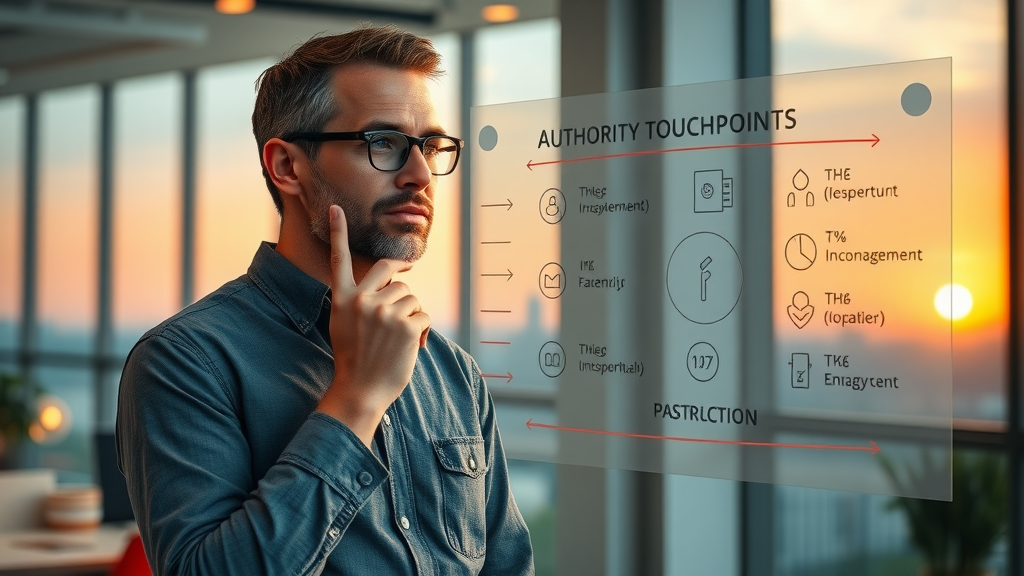"Brands that position themselves as authorities in their field see up to 2.5x higher conversion rates in lead generation campaigns."
Why Lead Generation Through Authority Is the Competitive Edge Today

- Startling facts: Over 60% of B2B buyers consider a brand's perceived authority before engaging. Exploring why building authority accelerates lead gen success.
- Defining lead generation through authority
- How consumer trust boosts lead generation
- Recent statistics on authority marketing
"Establishing authority marketing transforms passive followers into loyal leads."
In today’s saturated market, lead generation through authority is the difference between getting lost and standing out. While traditional approaches like cold calling or blasting ads might catch a fleeting glance, buyers now crave trust and authenticity above all. That’s why building authority matters: it helps you generate leads from potential customers who are ready to listen — and act. Recent research shows over 60% of B2B buyers evaluate a brand's expertise before engaging, making authority marketing a core pillar for any effective lead generation strategy.
Authority isn’t vague prestige; it’s a measurable asset. When buyers recognize you as a thought leader or an expert in your field, they’re more likely to convert, share your valuable content , and move swiftly through your sales funnel . In the end, brands who invest in authority generate leads at significantly higher rates, experience more loyal customer relationships, and gain a sizable advantage over the competition.
What You'll Learn from Mastering Lead Generation Through Authority
- How to leverage thought leader status for higher lead gen results
- Building authority marketing as the core of your marketing strategy
- Developing valuable content and content marketing assets to generate leads
- Actionable steps for integrating authority into your sales funnel
By the end of this comprehensive guide, you’ll know practical, step-by-step approaches to lead generation through authority . You’ll discover how to integrate authority marketing at the foundation of your marketing strategy , transform your brand into a thought leader, and create content marketing assets that generate leads reliably. Most importantly, you’ll learn how to nurture prospects at every stage of the sales funnel with strategies that work for any product or service, whether you’re in B2B or B2C.
You’ll also find actionable examples, real-world case studies, and expert quotes that reveal what winning brands are doing differently right now. If you want to stand out, build trust, and optimize your path to effective lead generation , this article gives you the roadmap.
Understanding Lead Generation Through Authority Marketing
Lead Gen Fundamentals in an Authority-Driven Marketplace

- What is lead generation through authority?
- Lead generation vs. traditional lead gen approaches
- The role of trust and brand perception
Lead generation through authority means generating leads by positioning your business—or yourself—as a recognized thought leader and trusted expert in your industry. This strategy differs sharply from legacy tactics such as cold calling or generic mass outreach. Rather than pushing your product or service on potential clients, you attract their attention by consistently providing valuable content, transparent insights, and proof of expertise.
Traditional lead gen relies on transactional interactions; authority marketing is relational. Buyers are far more likely to respond to someone who clearly understands their pain points and offers solutions proactively. When your marketing efforts foster trust, prospects engage, share, and eventually convert, because they believe in your expertise. In an era where information is everywhere, it’s trust and authenticity—earned through authority—that sets you apart from your competitors.
The Unique Role of Authority Marketing in Lead Generation
- Key differences between authority marketing and traditional marketing strategy
- Thought leader vs. thought leaders: Building a unique position
- Authority’s impact on marketing efforts and results
Authority marketing represents a proactive approach to lead generation , emphasizing reputation and trust over sheer volume outreach. Where traditional marketing strategies cast wide nets with limited personalization, authority marketing builds genuine relationships through demonstrated expertise, resonant storytelling, and valuable content that addresses target audience pain points.
The distinction between being a thought leader and just another “thought leader” is crucial: successful brands carve out a unique voice, offer original perspectives, and maintain consistency in messaging. As a result, the audience—be it individual potential clients or company decision-makers—begins to trust your insights, viewing your brand as the definitive answer in your space. This solid foundation allows for higher engagement, more qualified lead gen , and exponential growth in conversion rates.
Building Authority: The Cornerstone of Effective Lead Gen
Becoming a Thought Leader in Your Industry
- Key elements of becoming a thought leader
- Creating valuable content that resonates
- How thought leaders influence lead generation

Achieving thought leader status hinges on more than just technical knowledge. To become the voice your market trusts, focus on consistency and authenticity: share actionable insights through content marketing , engage in conversations relevant to your industry, and offer transparent opinions—even on contentious issues. Build trust by responding to target audience pain points publicly, providing resolutions or resources through webinars, blog posts , and digital events.
The most successful thought leaders produce valuable content tailored to every stage of the sales funnel . From introductory explainer videos to in-depth case studies, each asset demonstrates expertise while solving real-world problems for potential clients. As your authority grows, so does your ability to attract, qualify, and convert leads—because people want to buy from those they respect and remember.
Content Marketing as Authority Currency
- Content marketing strategies: Authority in action
- Leveraging social media and email marketing for reach
- Using valuable content to nurture and convert leads
"Content marketing done right is the silent driver of effective lead generation through authority."
Content marketing is the engine of authority marketing . Valuable, relevant, and consistent content signals expertise and keeps your brand top-of-mind. From whitepapers to explainer videos to expert interviews, each piece deepens the perceived value you offer. Smart marketers repurpose long-form material into shareable snippets on social media or into nurturing email marketing sequences. These efforts span the entire sales funnel —from awareness and consideration, to decision and advocacy.
Effective lead generation through authority means mapping your valuable content to your target audience’s needs at every touchpoint. This not only attracts new potential customers but keeps past clients engaged and referring others. In practice, it means publishing blog posts that address emerging trends, sharing case studies on complex solutions, and delivering actionable lead magnets—each reinforcing your reputation as an expert in your field.
Utilizing Social Media for Authority-Driven Lead Generation
- Selecting the right social media platforms for authority marketing
- Engagement tactics for building authority and generating leads
- Real-world examples of social media leadership

Social media isn’t just a broadcasting tool; it’s a dynamic platform for building authority and generating leads . Choose platforms where your target audience is most active—LinkedIn for B2B, Instagram or TikTok for creative industries—and tailor your messaging accordingly. Authority marketing on social media means sharing data-backed opinions, joining trending industry conversations, and offering micro-lessons that reinforce your credentials as a thought leader.
Use engagement tactics like live Q&A sessions, expert roundtables, and case study spotlights to inspire interaction and earn trust. Real-world leaders leverage social media not just to attract followers, but to invite dialogue, crowdsource content ideas, and directly respond to potential client questions. Each authentic interaction forms a bridge from social engagement to deeper, sales-focused conversations in your lead gen funnel.
Powerful Authority Marketing Strategies for Lead Generation
Tailoring Your Marketing Strategy for Authority-First Lead Gen
- Aligning marketing strategy with authority-building objectives
- Choosing between short-term and long-term approaches
- Integrating sales funnel stages with authority signals

An authority-first marketing strategy starts by clarifying where and how you want to be viewed as an expert. Define which topics, pain points, and solutions you want your brand associated with. Then, align your marketing efforts—content, campaigns, and partnerships—to reinforce this expert positioning consistently. Choose a blend of short-term tactics, like viral social media posts, and long-term investments, like signature studies or recurring webinars, to serve both immediate and future lead gen goals.
To fully harness the power of lead generation through authority , integrate authority-building techniques (like expert testimonials or proprietary data) into every stage of the sales funnel . Attract with visibility, convert with trust signals, nurture through regular valuable content, and close by being the brand your leads rely on for solutions. Authority isn’t built overnight, but a well-planned marketing strategy delivers compounding returns.
Creating and Distributing Valuable Content for Effective Lead Generation
- Types of valuable content for different stages of the sales funnel
- Content mapping: Matching authority topics to pain points
- Tips for maximizing content engagement
| Content Type | Best Use Case | Sales Funnel Stage |
|---|---|---|
| eBooks and Whitepapers | In-depth authority positioning and lead capture | Awareness & Consideration |
| Webinars & Live Events | Interactive expert engagement | Consideration & Decision |
| Case Studies & Testimonials | Proof of results and trust signals | Decision & Close |
| Blog Posts & Articles | SEO and ongoing thought leadership | Awareness & Engagement |
| Video Content & Podcasts | Engaging storytelling and brand personality | All Funnel Stages |
To generate leads at scale, diversify your content portfolio to meet prospects where they are in the sales funnel . Blog posts and industry articles attract new audiences by solving urgent questions, while webinars and ebooks dive deeper—trading high-value insights for contact information. Case studies, video testimonials, and data-driven whitepapers serve as authority anchors, driving credibility at decision points for potential customers.
Content mapping is essential: match your topics to the pain points and buying criteria your target audience faces. Use analytics and direct engagement to refine your titles and formats for maximum reach. The result is a content ecosystem that reinforces your expert in your field status and pulls qualified leads directly into your nurturing process.
Leveraging Email Marketing to Maintain Authority and Nurture Leads
- Building targeted email lists with authority positioning
- Email content that reinforces authority and generates leads
- Nurturing leads throughout the sales funnel via email

Email marketing is a direct, personal channel for nurturing leads with authority. Begin by building targeted lists—acquired through gated valuable content , event signups, or referrals—that reflect your niche expertise. Segment these lists by buyer personas and funnel stages, then craft emails that offer new insights, industry updates, or exclusive resources only available from you, the trusted thought leader.
The goal is to move leads from awareness to action by maintaining consistent, valuable communication. Use drip campaigns to introduce your top blogs, invite subscribers to webinars, or offer sneak peeks into upcoming projects. Effective sequences build trust, foster ongoing engagement, and accelerate your sales funnel velocity—not with aggressive selling, but by positioning your expertise as the solution to each potential client’s challenge.
Case Studies: Effective Lead Generation Tactics Using Authority Marketing
- Real-world examples of authority-led lead gen
- Measuring marketing efforts and ROI
- Common pitfalls and lessons learned
Consider the case of a SaaS startup that applied authority marketing by launching a comprehensive industry research report. By offering free access in exchange for contact information, the company built a segmented email list of high-intent prospects and attracted dozens of positive blog post mentions. Follow-up webinars and targeted nurture emails converted over 20% of these leads into paying customers—double the industry average for cold lead gen tactics.
Another example is a consulting firm that used LinkedIn articles and thought leader panels to showcase their approach to solving core industry pain points . By investing in authority-building techniques instead of high-frequency cold calling, they improved ROI, shortened sales cycles, and established lasting client relationships. Pitfalls often center around inconsistency—if your messaging and expert content aren’t aligned, or if you fail to maintain engagement, prospects will drop off before conversion.
Developing a Sustainable Lead Generation System Through Authority
Long-Term Marketing Strategies for Authority and Lead Gen
- Sustaining thought leader status in competitive markets
- Continuous valuable content creation
- Adapting to evolving market trends

Sustaining thought leader status demands constant vigilance and adaptation. As competitors enter the market and audience preferences evolve, your team must commit to ongoing research, content updates, and a willingness to experiment with new media and formats. Maintain authority by tracking industry developments, attending events, and collaborating with other thought leaders for mutual credibility.
A sustainable lead generation strategy also depends on regularly publishing new valuable content . Use analytics to spot emerging pain points and create timely resources that keep you ahead of the curve. This proactive approach demonstrates your expertise year after year, ensuring your brand is always seen as a knowledge leader.
Building a Sales Funnel that Converts Through Authority
- Effective lead capture and qualification processes
- Nurture and trust-building sequences
- Sales funnel optimization for authority marketing
A high-converting sales funnel for lead generation through authority begins at the top: attract leads with authority marketing content and capture information through well-designed forms or landing pages. Use lead scoring to qualify prospects, ensuring you focus resources on those most likely to engage. Next, nurture with multi-step email sequences and offer value at each interaction—think exclusive guides, early-access webinars, or tailored demos.
Optimize your funnel by testing messaging, tracking conversions at each stage, and addressing drop-offs quickly. Authority marketing shortens sales cycles because prospects arrive already convinced of your credibility and approach, making conversion conversations both more productive and more predictable.
People Also Ask: Deeper Insights Into Lead Generation Through Authority
What are the four L’s of a lead generation strategy?
- Learn : Understand your audience pain points
- Locate : Identify where your audience consumes content
- Leverage : Use authority-based marketing strategies
- Lead : Guide prospects through the sales funnel towards conversion
The four L’s—Learn, Locate, Leverage, and Lead—structure your journey to effective lead generation . First, understand what challenges, or pain points, your target audience is facing. Next, discover the social media platforms, blogs, or communities where they spend their time. Then, leverage authority marketing tactics to deliver tailored, valuable content, and finally, guide prospects through your optimized funnel toward a sale.
Who is responsible for generating leads?
- Marketing teams : Implement authority marketing and content distribution
- Sales teams : Engage and convert nurtured leads
- Executives : Set overall marketing strategy and authority branding
Responsibility for generating leads falls across the entire business. Marketing teams create and distribute authority-based content and campaigns, while sales teams interact directly with warm leads, guiding them toward conversion. Executives, meanwhile, establish the overarching strategy and authority branding, ensuring every touchpoint reflects your position as an expert in your field—setting the tone for marketing efforts company-wide.
What are the four steps of lead generation?
- Attract : Bring in leads via valuable content marketing and social media
- Convert : Capture lead information through authority-led offers
- Nurture : Develop relationships using email marketing and continuous content
- Close : Drive the qualified lead through the sales funnel to sales
To generate leads effectively: start by attracting attention with highly relevant content marketing and engaging social media posts. Convert interested prospects by offering valuable assets in exchange for contact information—think downloadable guides or invitations to exclusive webinars. Nurture leads with ongoing targeted communication, especially through email marketing . Finally, use authority and trust to close deals and transform prospects into loyal clients.
What are the best lead generation strategies?
- Build authority with thought leadership and content marketing
- Use social media and influencer collaborations
- Create pain point-specific valuable content
- Implement multi-step sales funnel journeys
The top lead generation strategies focus on building authority , showcasing your expertise through valuable content , and fostering authentic connections on social media . Collaborating with other thought leaders or industry influencers can amplify your message. Most importantly, map out a full sales funnel , guiding each prospect from awareness to conversion using well-crafted authority signals at every stage.
Expert Insights: Quotes on Lead Generation, Authority Marketing, and Content Marketing
"Authority is earned through consistency, expertise, and authenticity—these are the pillars of sustainable lead generation."
"Every marketing strategy should have authority at its heart to efficiently generate leads and drive business growth."
Action Plan: Steps to Win at Lead Generation Through Authority
- Audit your current authority presence and marketing strategy
- Identify key content marketing gaps for building thought leader status
- Map out your valuable content plan for the sales funnel
- Leverage social media and email marketing channels
- Measure, optimize, and amplify successful marketing efforts

Begin by assessing how your brand is currently perceived: do you already have authority in your niche, or is there room to grow? Close any gaps by focusing on content marketing , mapping out blogs, case studies, and thought leadership pieces to support each phase of the sales funnel . Next, invest in social media and email marketing channels to distribute your insights and nurture leads at scale. Continually analyze what’s working—and double down on the campaigns that are bringing the most qualified potential customers through your doors.
Frequently Asked Questions About Lead Generation Through Authority
-
How quickly can lead generation through authority show results?
Results depend on your starting authority, content quality, and industry competition. Some see increased engagement in weeks, while measurable sales funnel impact can take three to six months of consistent effort. -
What tools best support authority-led content marketing?
Use platforms like HubSpot, LinkedIn, SEMrush, and Mailchimp for content management, analytics, and email automation. Social platforms help amplify your messaging to the right audience. -
Can small businesses benefit from authority marketing?
Absolutely! Authority isn’t about budget or size. Niche expertise, authentic storytelling, and valuable content are often easier to focus in smaller organizations, helping them outshine bigger competitors. -
How does authority influence different stages of the sales funnel?
Authority marketing accelerates every phase—attracting more leads at the top, increasing trust in the middle, and smoothing conversion at the bottom by assuring prospects they’ll get results from a true expert.
Maximizing Your Results With Authority-Driven Lead Gen
- Consistently revisit and refine your authority marketing strategy
- Invest in continuous learning as a thought leader
- Prioritize valuable content and adapt to evolving audience pain points
"Winning at lead generation is about being the voice your market trusts most — make authority your ultimate marketing strategy."
Conclusion
Start investing in lead generation through authority today—audit your strengths, fill content gaps, and become the trusted choice. Lasting results favor those who act with credibility, consistency, and expertise.
 Add Row
Add Row  Add
Add 




Write A Comment